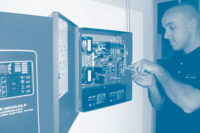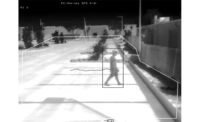Whichever type of camera a dealer is using, a big advantage of domes – which typically have a smoked appearance – is that they help deter would-be troublemakers. “No one knows which way the camera is pointing,†notes Mike Cosenza, president of installing company Alternative Security in New City, N.Y. “That gives a sense of security for the customer.â€
PTZ or Fixed?
Advance Technology, a Scarborough, Maine-based security installing company, uses both fixed and pan/tilt/zoom (PTZ) domed cameras, depending on a customer’s needs. On average, PTZ cameras cost about three times as much as fixed cameras, notes Advance Technology owner Jesse Abbott. “When you get to three fixed cameras for an installation, you’re at the price of a PTZ; then you have to ask yourself, ‘Will a PTZ provide better value?’ If you just want to watch three locations, fixed cameras are better because you won’t be watching the parking lot when you want to watch a door.â€Because PTZ cameras generally are larger than fixed cameras, fixed cameras also may be the preferred choice for customers who are particularly concerned about aesthetics. Abbott often uses fixed mini-dome cameras, measuring only about five inches in diameter, for installations where appearance is a chief consideration. In comparison with traditional fixed cameras, he says, the dome also adds an extra level of protection. “The lens doesn’t get bumped and the cleaners don’t hit it with a dusting cloth,†he says.
Abbott notes, however, that there are some situations in which a PTZ camera is the only viable choice. “If the customer needs to see five different directions around the corner of a building and needs to zoom in on a license plate, a fixed camera won’t do it,†he says.
There are several factors that security dealers should consider when selecting PTZ cameras. “One of the features they need to think about is the number of pre-set positions that can be preprogrammed into the camera,†notes Allan Lamberti, director of sales for camera maker TOA Electronics in South San Francisco, Calif. Pre-sets are a series of positions that a camera can be programmed to automatically go through during the course of a day to help ensure that an entire area is covered. “People are trying to find ways to eliminate guards,†Lamberti explains.
Regarding pre-sets, “80 is generally a pretty good number to shoot for,†advises Terry McBride, inside sales manager for another camera vendor – Monmouth Junction, N.J.-based Infinova. Pre-sets are particularly useful if a video surveillance system is integrated with an alarm or access control system because the camera can be programmed to go to an appropriate pre-set position when a certain event occurs. For example, McBride says, “You can trigger a pre-set if someone swipes a badge on the access control system that’s not authorized.â€
How quickly the PTZ camera can change positions is another consideration. McBride advises dealers to look for a camera that can move up to 280 degrees per second when moving into a pre-set position or up to 100 degrees per second when security personnel are controlling the device manually. Speed domes, which have the ability to quickly move through a series of positions, are one of the fastest growing types of PTZ cameras, notes David Price, marketing manager for camera maker Digimerge Technologies Inc. in Toronto. “Speed would be an issue if you’ve got a lot of points to monitor with a single camera or if the threat is particularly fast moving.â€
Dealers also should consider the camera’s ability to zoom – a decision complicated by the fact that many cameras have an optical as well as a digital zoom. “Most people buy based on what the optical zoom can do,†notes Grady Speaks, vice president of camera manufacturer EverFocus Electronic Corp. in Duarte, Calif. An optical zoom makes far objects appear closer by using a series of adjustments to an optical lens, Speaks explains, adding that an optical zoom of 23 is the cut-off point between a medium-grade and high-end camera. “Most manufacturers add a digital zoom,†Speaks continues. “Instead of zooming manually through the optics, you blow up the pixels,†he says. “By the twelfth zoom in, it gets pretty blurry.â€
Fixed cameras are not as complicated as PTZ models, which, on one hand, can simplify the selection process. On the other hand, because fixed cameras may have few adjustments, that means it’s crucial to buy the right lens for the particular application. Cosenza, who usually installs fixed cameras, has standardized on varifocal lenses for fixed camera installations. The focal length of varifocal lenses can be set as needed at the time of installation. “Otherwise you need a lot of lenses,†Cosenza says.
Housings
Whether buying a PTZ or fixed domed camera, it’s also important to think about the environment in which the camera will be installed. Some cameras have vandal-resistant domes, which can be important when a camera is mounted in an area that could be reached with a baseball bat or weapon. Other cameras may require a separate housing for vandal protection.Advance Technology uses a lot of ruggedized, mini-dome fixed cameras for use next to access card readers. That approach enables the device to be installed low enough so that it can clearly see the face of anyone using the card reader. “We like to get right in your face,†Abbott notes. “With a ruggedized dome, you can do that.â€
If a camera will be used outside, dealers have a couple of different alternatives for ensuring adequate image quality during dark nighttime hours. One option is to use a day/night model. Such devices work without a mechanical switch, explains Cheryl Bard, product marketing manager for equipment vendor Bosch in its Lancaster, Pa., office. “When the camera senses that it is nighttime, there is a boost in sensitivity and it switches to monochrome,†she says.
The other option for cameras that will be used outdoors at night is infrared illumination, which is achieved through LEDs installed inside the housing. “IR illumination within a housing can light up a scene,†notes Price. In selecting IR illumination, Price says, the rule of thumb is one foot per LED. The downside, he says, is that if something gets too close to the camera, it can create a bright flash in the image. “Be careful with IR,†Price advises. “You want enough to light an area but not so much that the images are glared.â€
Special housings also may be needed if a camera will be installed outside. “For cold areas you need a heater and for certain areas, you need a hidden blower,†explains David Liu, vice president of equipment supplier Bolide Technology Group in City of Industry, Calif. Sunshields also can be important for some outdoor applications, notes Gilbert DeLiso, national CCTV sales manager for video equipment vendor ELMO USA Corp. in Plainview, N.Y. “A camera installed on top of a telephone pole in Nebraska in the sunlight in summertime can get just as hot as one installed in the desert,†DeLiso says.
Some clients may require that a camera housing meet certain standards. The IP66 standard is aimed at protecting against water damage, while the NEMA-3 standard covers dirt, dust and other hazards. (See sidebar.) Another method for protecting against dust – as in certain manufacturing environments – is to use housings with a pressurized seal.
Traditional mountings may not be workable for outdoor installations, notes Anthony S. Hong, who works in technical sales and R&D at manufacturer Vitek Industrial Video Products Inc. in Sun Valley, Calif. “The outdoor application is more creative, as there are various mounts and options, such as parapet, goose neck and such to place these cameras strategically in optimal locations,†he says. As with many types of security equipment, some of the most important features of domed cameras are those that determine how easily an installation can be made. To help ensure that a camera is level when mounting it on a wall rather than a ceiling, Hong recommends using a three-axis gimbal.
Another important factor to consider is whether the camera can be easily adjusted to look slightly above a horizontal plane, notes DeLiso. Citing the example of a camera installed under an eave looking into a parking lot that slopes up, he says, “There’s frequently a need for the camera to look slightly above the horizontal.â€
Adds Cosenza, “I like the domed camera to be able to be opened and closed easily without the camera itself being moved. If you get it adjusted, then close it and the camera moves, it’s a problem.†When a separate housing is required, Cosenza tries to buy one from the same manufacturer as the camera because he finds that such devices tend to fit together more easily. “I don’t like to mix and match because it makes for easier installation,†he says.
Winter Tips from the Field
Heaters are essential for cameras installed outdoors in cold climates. When selecting a camera and housing with a heater, Mike Cosenza, president of installing company Alternative Security in New City, N.Y., advises dealers to look for a heater than can be easily replaced if necessary. “You want to be able to change the heater out without changing the entire housing,†Cosenza says.Jessee Abbott, owner of security installing company Advance Technology of Scarborough, Maine, is a big fan of domed cameras with pressurized housings. As he explains it, pressurized housings are filled with nitrogen, a non-combustible gas that causes continuous outward pressure against the seal, making it virtually impossible for anything to get inside. “We’ve put pressurized domes on top of a mountain to watch a ski lift,†Abbott says. “When the wind is blowing at 100 miles per hour, it will force its way into almost anything. But if the dome is pressurized, it can’t get in.â€

